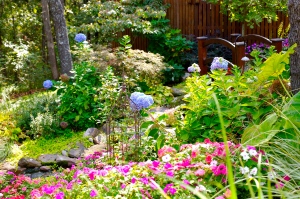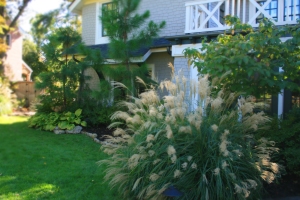
We all would love more time. While gardening can be therapeutic, taking care of your landscape can take up much of your time, energy, as well as money. That’s why many homeowners are opting for low maintenance landscape design in Tulsa. Low maintenance landscaping is just that; it requires less maintenance as well as requiring less water. But this doesn’t mean that these landscapes have to be filled with cacti or have a desert-like feel. No, these landscapes can be very colorful all year round.
One important aspect of creating a more low maintenance landscape is using plants that are native to your local region. These plants are naturally more resistant to diseases and insects in the area and can survive better in the local climate. Native and drought-tolerant plants are less prone to be overtaken by weeds and often require less water. All of this translates to less maintenance. And it just makes sense that if these plant species can survive in the wild on their own, they will take far less maintenance than exotic plants that are used to a totally different climate. Oklahoma Landscape’s horticulturists can help you find colorful and lively native plants that will perfectly complement your landscape and home.
 Choosing drought-tolerant plants is part of a landscape design known as xeriscaping or dry gardens. This doesn’t mean that no water is used, but that water conservation techniques are employed in the landscape design to reduce the need for water while still creating a sustainable and beautiful landscape. As with low maintenance landscape design, xeriscaping involves not only choosing plants that will thrive in the local climate and are resistant to drought, but also planting and grouping them in ways that will require less maintenance.
Choosing drought-tolerant plants is part of a landscape design known as xeriscaping or dry gardens. This doesn’t mean that no water is used, but that water conservation techniques are employed in the landscape design to reduce the need for water while still creating a sustainable and beautiful landscape. As with low maintenance landscape design, xeriscaping involves not only choosing plants that will thrive in the local climate and are resistant to drought, but also planting and grouping them in ways that will require less maintenance.Effective planning is vital for your Tulsa landscape to become a low maintenance garden or xeriscape. Grouping plants together that have similar watering and sunlight needs will make it easier to care for them. Noting the terrain of your landscape and the way rain drains can help you prevent erosion by using terraces and other landscape features to reduce soil loss. In shaded areas where grass is hard to grow, ground covers and flowers that thrive in shade can be used to replace turf. Grass on slopes can be replaced by low-maintenance ground cover to reduce difficult lawn mowing. Analyzing and planning areas with more traffic can help you decide whether to introduce a ground cover or even a hardscape like a walkway or patio that will greatly reduce maintenance by replacing turf. This does not mean replacing your entire lawn, but simply designing turf areas in a more thoughtful way to maximize their effectiveness by balancing practicality. For instance, large, open spaces may be more practical with turf, but narrower, shaded areas where grass doesn’t grow well may need more native plants, rocks, and shrubs.
Planning also involves ensuring your soil is well-nourished so as to reduce the need for water. Aerating the soil and using a good fertilizer or compost can help improve your soil, helping it to retain the water it needs for plants and grass to flourish. Using mulch around plants can help prevent weeds and erosion while also helping the soil retain its moisture.
Drip irrigation systems can be used to maximize the effectiveness of irrigating while conserving water. With this type of irrigation, water loss due to evaporation, surface runoff, and wind is virtually eliminated. A slow, steady application of water directly to the plant’s root system is the best way to ensure plant health and vitality. In general, drip irrigation applications use 30 to 70 percent less water than an overhead irrigation system, and plants grow to maturity about twice as fast.
A low maintenance landscape doesn’t have to dull, but can be vibrant, full of colorful plants and using a variety of themes and designs. These landscapes can reduce watering costs, time in maintaining, reduce pollution, and increase the value of your home with sustainable landscape design practices. Oklahoma Landscape can design the best low maintenance landscape for your home so that you’ll have more time to “find yourself outside.”

Marion Landscape's xeriscaping is both elegant and useful. Fantastic backyard ideas for Mariners—no more dead grass or excessive water expenditures.
ReplyDeletexeriscaping backyard landscaping ideas in Marin County